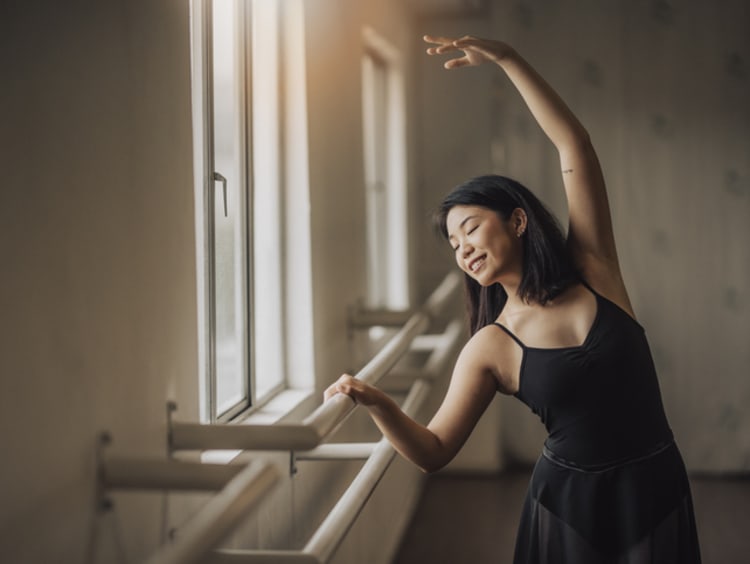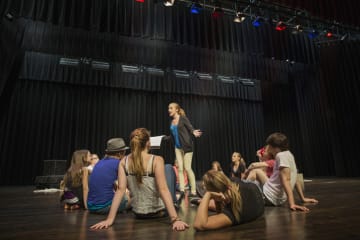How To Take Care of Your Body as a Dancer in College

Dancing is a very physically demanding sport and to avoid the risk of getting sick or injured, you must make sure you take care of your dancer’s body. Your body is your instrument and you don’t want it to break! Here’s a look at how to take care of your body while putting it through rigorous dancer’s workouts.
In This Article:
- How To Take Care of Your Body With a Healthy Diet
- A Dancer’s Body Needs to Stay Well-Hydrated
- Prioritize Healthy Sleep Habits
- Taking a Break From a Dancer’s Workout
- “Taking Care of My Body” Starts With Listening to It
How To Take Care of Your Body With a Healthy Diet
When you’re working toward a dance degree, you are almost always moving and doing a lot of physical activity. To make sure your body stays healthy and strong, you want to be sure you are consuming enough calories. With class and rehearsals, a dancer wants to replenish the nutrients they lost throughout the day.
Some good foods to look at are complex carbs such as whole-grain bread and pasta, and brown rice. In addition, protein from foods like tofu and poultry help repair frequently used muscle tissue. You want to make sure you eat from all of the major food groups; eating a variety of foods every day is important. Here’s a look at the recommended number of servings per food group:1
- Grains – Women: nine servings; men: 11 servings
- Vegetables – Women: four servings; men: five servings
- Fruits – Women: three servings; men: four servings
- Milk, yogurt and cheese – Women: two or three servings; men: two or three servings
- Meat, beans, eggs and nuts – Women: six ounces; men: seven ounces
However, if your doctor recommends a specific diet for you, you should defer to your physician’s guidance.
Calorie Needs
Dancers need to be well fueled for classes, rehearsals and performances. As a dancer, it can be challenging to consume an adequate amount of food to meet your energy needs and the demand on your dancer’s body. Consuming too few calories may compromise a dancer’s energy availability and may hinder the artist’s performance. In addition, low-calorie diets come with a lack of macronutrients that alter growth, performance and overall health. Every individual has a different caloric need based on a variety of different factors, but you should always aim to consume enough macronutrients daily for proper nutrition and a long-lasting professional dance career. If you aren’t sure what your daily caloric needs are, consider talking to a healthcare professional or nutritionist for personalized guidance.
Carbohydrates
One of the greatest and quickest sources of energy for a dancer is by consumption of carbohydrates. Carbohydrates break down into glucose to quickly fuel muscles. Without glucose, a dancer’s body, skills and strength could be compromised and muscle fatigue could compromise their performance. A diet rich in whole grains and complex carbohydrates can help a dancer last through prolonged periods of training. In addition to meals, dancers should also incorporate some form of carbohydrates into their diet before, during and after classes, rehearsals or performances. Before and during training, dancers should ingest quick energy carbohydrates (simple carbohydrates) such as fruit, and after rehearsal they should focus on refueling their energy stores with healthy sources of carbohydrates like rice, beans and whole-grain pasta. Carbohydrates are essential for a dancer to perform at their very best, and without proper intake of carbohydrates, dancers may experience fatigue.
Fats
When many people hear the word “fats,” they automatically assume that those foods are bad for you. However, certain fats are essential in a dancer’s diet. Good fats provide structure for our cells, insulate our nerves and are the base of many of our hormones. Muscles and adipose (fat) tissue store fats as triglycerides and when dancing, these fat stores are broken down into different fatty acids that produce energy for our bodies. Healthy fats are needed to fuel the muscles for energy, as well as to allow for the absorption of fat-soluble vitamins. In endurance activities like dance, fats become a very important part of our diet to provide lasting energy. Some healthy fats that dancers can incorporate into their diet are nuts, olive oil and avocados.
Protein
For all dancers, and in particular, developing dancers, protein is vital regardless of whether the goal is to build muscle or not. Without protein, our muscles would not be able to support our goals of increased performance and a prolonged professional dance career. Our muscles are constantly being used in dance, therefore, protein is needed for building and repairing muscle tissue. Some healthy sources of protein include chicken, fish, turkey, beans, quinoa, nuts and tofu. Protein is essential to maintain and build strength for a dancer’s body; therefore, it is important to consume an adequate amount of protein every day to help ensure a long, healthy dance career.
Micronutrients
Sometimes, dancers become so focused on making sure they get in the essential macronutrients that they forget that micronutrients are just as important in the healthy lifestyle of an artist. The two micronutrients necessary for human functioning are vitamins and minerals. For instance, B vitamins play an important role in energy production and while they do not directly supply energy for the body, they are used in the body to help make carbohydrates, fats, proteins and red blood cells. Other vitamins essential for health are vitamins A, C, E, D and K that help repair damaged muscles that are overstressed/overused and play key roles in bone metabolism. Two of the most essential minerals for a dancer are calcium and iron. Calcium is needed for bone growth. Calcium can also decrease the risk of stress fractures. Iron is what dancers’ bodies use to carry oxygen to the blood and is needed to produce energy. Being mindful of proper nutrition as an adolescent and young adult is important for sustaining a long and healthy professional dance career. Without proper nutrition, you are putting your body at risk of injury, lack of strength and nutrient deficiencies, as dance is a very demanding art form on the body. Focus on creating a well-balanced diet with fruits and vegetables and honoring when your body needs fuel so you can perform at your absolute best.
A Dancer’s Body Needs to Stay Well-Hydrated
This is something that is not only important in Arizona, but for every dancer out there. While dancing, you will lose fluids, no matter how long you are practicing or performing. You should drink water continuously throughout the day to stay hydrated.
Sports drinks can help you rehydrate, but they also contain a fair amount of sodium. The bulk of your fluid intake should be water. Keep a reusable water bottle with you at all times and sip throughout the day. Soda and coffee do not count toward the daily intake of water.
Prioritize Healthy Sleep Habits
Sleep can be something foreign to most college students, but it truly is important for maintaining one’s physical and mental health. Sleeps supports your memory, energy levels and concentration. Having a good night’s rest means you’ll be at peak performance for your class or competition.
Try to get about seven to eight hours of sleep per night. It’s best to maintain a regular, consistent sleep schedule. When you fall asleep and wake up at the same times each day you’ll be less susceptible to insomnia and more likely to feel well-rested.
Taking a Break From a Dancer’s Workout
While dancing and practicing are important, it is also vital to get out and have a little fun. Go to a basketball game with your roommates or an event on campus. Head over to GCBC on GCU's campus and grab a coffee or have dinner with friends.
You will no doubt be busy working toward your dance degree, but at least once a week, try to take a breather. You don’t want to spend your whole college career nestled in a studio. You want to enjoy campus life and embrace being a Lope. It not only can give you relief physically, it can also support your mental and emotional wellness.
“Taking Care of My Body” Starts With Listening to It
Your passion for dance may overwhelm any pain or sickness that could prevent you from dancing. However, you should always listen to your body and what it is telling you. If not, you can risk getting worse and jeopardizing your career altogether. If you think you may have sustained an injury or aren’t feeling well, notify your dance instructor and visit a healthcare provider promptly.
If you’re interested in pursuing a career in dance, learn more about GCU’s Bachelor of Arts in Dance or Bachelor of Arts in Dance for Secondary Education programs. Our artistic dance community looks forward to welcoming you! Complete the form on this page to learn more about these and other degree programs within the College of Arts and Media.
Approved by the director of health services of the Canyon Health and Wellness Clinic and the director of dance of the College of Arts and Media on June 29, 2023.
The views and opinions expressed in this article are those of the author’s and do not necessarily reflect the official policy or position of Grand Canyon University. Any sources cited were accurate as of the publish date.


